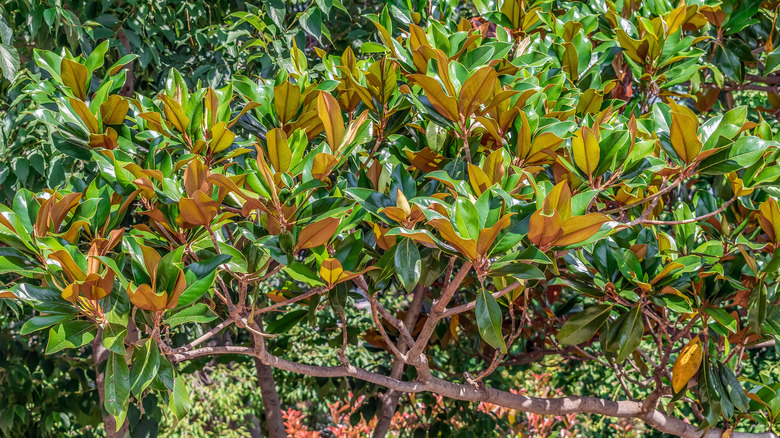What To Do If You Find Brown Leaves On Your Magnolia Tree
Valued for their fragrant white, pink, purple, or yellow blossoms, magnolia trees (Magnolia grandiflora) are popular with gardeners seeking to add visual interest to their landscape. However, at times, the leaves of these elegant trees turn brown and fall off, marring their aesthetic appeal while leaving their planters confused. But not all browning leaves are a cause for concern, as magnolia trees naturally shed their old leaves as they mature. This phenomenon is even more apparent in their deciduous varieties, like the saucer magnolia, whose leaves discolor and drop down during the fall.
But if the foliage continues to lose its green hue even when natural aging is not at play, it's time to pay attention to environmental stressors and growth conditions. Magnolia's visage may become unappealing when exposed to frost, cold winds, or extreme heat. Poor irrigation practices, nutritional deficiencies, and pest and fungal attacks may also cause leaf discoloration. Removing the damaged foliage and improving the growth environment can help restore your hardy tree.
Dealing with environmentally stressed magnolia
If your magnolia trees persistently display droopy, brown leaves in the spring, they're most likely suffering from winter leaf scorch or frost damage. Although your magnificent trees are unlikely to die from cold damage, you must prune the already dead foliage to redirect their resources to growing new leaves. Consider moving young plants to a more sheltered location or covering them temporarily with a porous sheet before frost sets in. This will also protect your hardy vegetation against icy cold winds, possibly causing leaf discoloration from windburn.
To protect mature trees, spray their leaves with antitranspirant or use a patio heater to keep them warm. However, if your plants grow in dry areas and experience harsh winds, water the soil until moist to minimize leaf damage. It'll help maintain relatively warmer temperatures above the trees' roots compared to their surroundings. You can also spread mulch around the tree's base to improve moisture retention and manage wind action.
Solving unfavorable growth conditions
But if your magnolia leaves turn yellow and brown during the summer months, it indicates drought stress. You may also notice the branches becoming weak and brittle. Deeply water the top 6 inches of the soil and cover it with mulch to keep your trees well hydrated. Also, ensure you don't overwater the plant, as it may cause root rot, leading to the darkening of leaves and root decay. It may even make your trees more susceptible to fungal diseases and pest infestations. Improving soil drainage, reducing irrigation frequency, or repotting the plant should help resolve the overwatering issue.
Another reason for leaf discoloration during the summer is excessive exposure to sunlight. Shading your magnolia tree at noon should help stave off leaf scorch. But if the leaves fall right after they turn brown, the tree's soil may be low on iron and should be treated with a suitable fertilizer. If none of these scenarios apply, your magnolia plants are likely suffering from fungal diseases such as phyllosticta leaf spot, leaf blight, or verticillium wilt. Deal with them by removing all diseased branches and applying herbicide.


